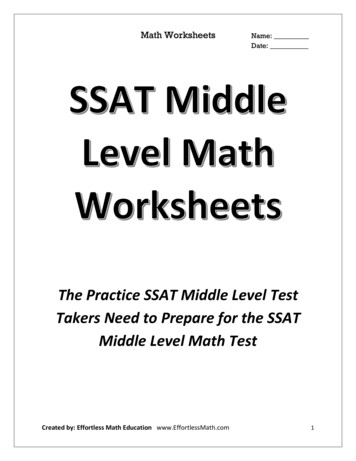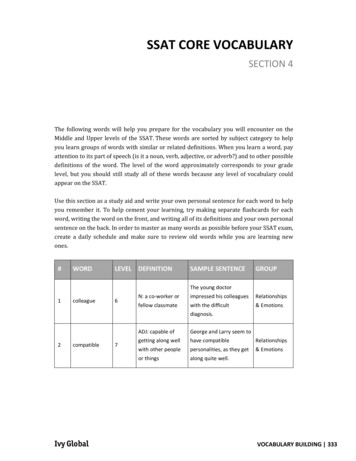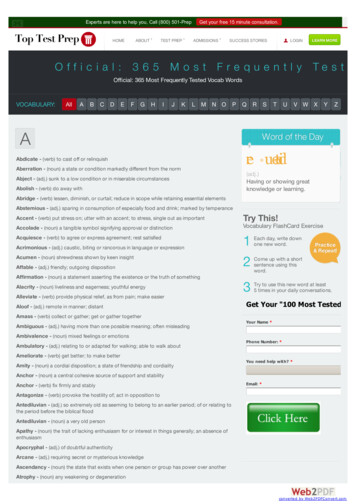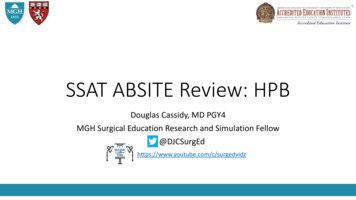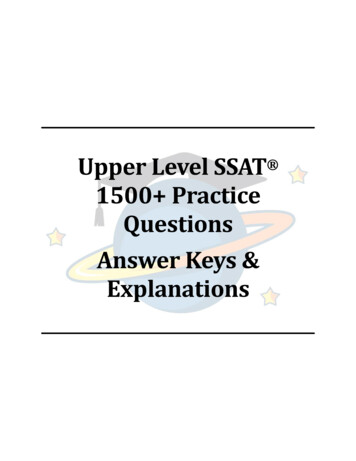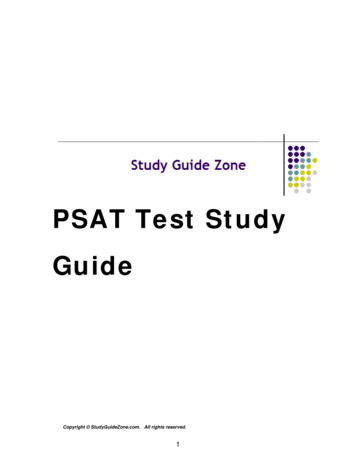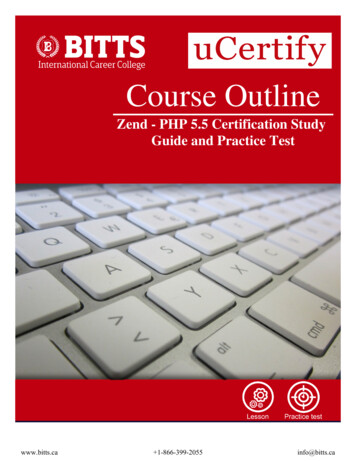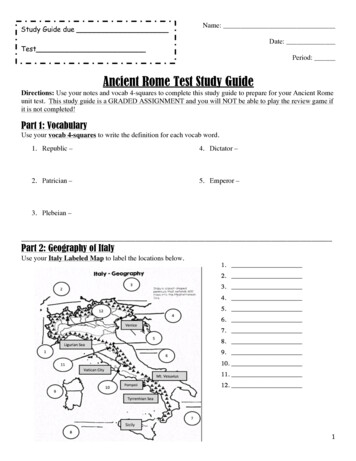
Transcription
SSAT Test StudyGuideCopyright StudyGuideZone.com. All rights reserved.1
Table of ContentsSSAT TEST RESOURCES . 4SSAT OVERVIEW . 5TESTING AND ANALYSIS. 7INTRODUCTION TO THE SSAT. 9THE SSAT SCORING SCALE. 10QUANTITATIVE TEST . 12QUESTION TYPES . 13ARITHMETIC . 13DIVISIBILITY . 15MULTIPLICATION . 16ADDITION . 16SUBTRACTION . 17EVENS AND ODDS . 18PRIME NUMBERS . 20PERCENTS . 22SQUARE OF A NUMBER . 25EXPONENTS . 27ROOTS . 29AVERAGES . 30VERBAL TEST . 32SYNONYMS AND ANALOGIES. 32Characteristic . 32Source. 32Location. 32Sequential . 32Reciprocal. 33Cause/Effect . 33Creator/Creation. 33Provider/Provision . 33Copyright StudyGuideZone.com. All rights reserved.2
Object/Function. 33User/Tool . 34Whole/Part . 34Category . 34Synonym or Definition. 34Antonym or Contrast. 34Intensity. 35Word Part/ Meaning . 35USING SENTENCES . 35FOCUS ON WHAT YOU KNOW . 35READING COMPREHENSION TEST . 37FLYING OVER THE PASSAGE . 37CREATING A TENTATIVE SUMMARY . 37OPENINGS AND ENDINGS . 38EXTRANEOUS INFORMATION . 39USING KITCHEN LOGIC . 39GETTING INTO THE AUTHOR’S MIND . 40EMOTIONAL WORDS . 41FINDING THE KEY WORDS . 42MAKING PROPER INFERENCES . 43APPLYING IDEAS FOR GENERALIZATIONS . 44USING CONTEXT CLUES . 44BREAKING DOWN PASSAGE ORGANIZATION . 46FIRST WORD ANALYSIS . 47UNDERSTANDING THE INTIMIDATION . 48FINDING YOUR OPTIMAL PACE . 49DON’T BE A PERFECTIONIST . 50FACTUALLY CORRECT, BUT ACTUALLY WRONG . 51DIFFERENT VIEWPOINTS . 51WRITING SAMPLE . 53PLANNING STAGE . 53STICKING TO THE PLAN. 53REVIEWING THE PLAN . 53BRAINSTORMING SMART . 54Copyright StudyGuideZone.com. All rights reserved.3
MAKING THE CUTS . 56ENDING AT THE START . 57STAYING CONSISTENT . 58MAINTAINING THE FLOW. 59BACKING UP YOUR POINTS . 59USING PROPER GRAMMAR . 60WATCHING YOUR VOCABULARY . 61AVOIDING TUNNEL VISION . 62JUST DO IT . 63CONCLUSION IS REVIEW. 64COMMUNICATING REASON, NOT PASSION . 64ANSWERING THE WHY? . 65GETTING READY FOR TEST DAY. 67POST SSAT . 69SSAT Test ResourcesFree SSAT Practice Testshttp://www.testprepreview.com/ssat practice.htmFinancial Aid Factshttp://www.finaidfacts.orgScholarship Helphttp://www.scholarshiphelp.orgStudy Tips and Informationhttp://www.studyguidezone.com/resource tips.htmCopyright StudyGuideZone.com. All rights reserved.4
SSAT OverviewThe SSAT is indeed a difficult examination, and as such, it wasrequired that media be chosen by which intellectual ability could bemeasured. In the case of the SSAT, math, verbal, reading, and writingwere the selected media. While there is an ongoing, low-profilecontroversy about whether or not this test truly measure’s yourabilities with regards to what skills you’ll need for school, that is notthe purpose of this book. The purpose is, however, to make sure thatyou’re able to achieve the best possible state of preparation, allowingyou to maximize your score potential - no matter if your actualaptitude has been measured.As no test can measure all aspects of a person’s intelligence, the SSATmeasures those skills deemed most critical to a new student. Thenagain, if any admission test, no matter how cleverly assembles, isinherently inadequate, why perform this type of testing at all? This isa question posed by every student who sees the SSAT looming aheadof him/her. Nevertheless, the answer to this question is quite simple,and quite reasonable; to make school acceptance a more fairexperience, by expanding the basis approval beyond your grades.Your SSAT score is one of the most critical elements to yourqualification for school, so it is naturally much too important for you totake this test unprepared. The higher your SSAT score, the betteryour chances of admission will be for a respected, competitiveprogram.Copyright StudyGuideZone.com. All rights reserved.5
While different programs assign a different weight or importance toyour SSAT scores, it is safe to assume that your SSAT will be a majordetermining factor when it comes to the final admission decision madeby each school to which you’ve applied.Careful preparation, as described in this expert guide, along with hardwork, will dramatically enhance your probability of success. In fact, itis wise to apply this philosophy not only to your school applications,but to other elements of your life as well, to raise you above thecompetition. Your SSAT score is one of the areas in the admissionprocess over which you have a substantial amount of control; thisopportunity should not be taken lightly. Hence, a rational, preparedapproach to your SSAT test as well as the rest of the admissionprocess will contribute considerably to the likelihood of acceptance.Keep in mind, that although it is possible to take an SSAT test morethan once, you should never take the test as an “experiment” just tosee how well you do. It is of extreme importance that you always beprepared to do your best when taking the SSAT.Copyright StudyGuideZone.com. All rights reserved.6
Testing and AnalysisIt won’t take you long to discover that the SSAT is unlike any testyou’ve taken before, and it is probably unlike any test you will evertake again in your academic career. The typical school test is aknowledge-based test. The SSAT, however, is skills-based.What does this mean to you? It means that you’ll have to prepareyourself in a completely different way! You won’t simply be recitingmemorized facts as they were phrased in some textbook.The SSAT requires you to think in a thorough, quick and strategicmanner and still be accurate, logical and wise.This test is designed to judge your writing, verbal and mathematicalability in the ways that schools feel is vital to the success of first yearstudents.To some extent, you have already gradually obtained these abilitiesover the length of your academic career. However, what you probablyhave not yet become familiar with is the capability to use theseabilities for the purpose of maximizing performance within the complexand profound environment of a standardized, skills-based examination.There are different strategies, mindsets and perspectives that you willbe required to apply throughout the SSAT. You’ll need to be preparedto use your whole brain as far as thinking and assessment isconcerned, and you’ll need to do this in a timely manner. This is notCopyright StudyGuideZone.com. All rights reserved.7
something you can learn from taking a course or reading a book, but itis something you can develop through practice and concentration.This guide provides you with the professional instruction you requirefor understanding the traditional SSAT test. Covered are all aspects ofthe test and preparation procedures that you will require throughoutthe process. Upon completion of this guide, you’ll have the confidenceand knowledge you need for maximizing your performance on yourSSAT.Copyright StudyGuideZone.com. All rights reserved.8
Introduction to the SSATThe purpose of the SSAT is to establish a standard method ofmeasurement for the skills that have been acquired by schoolapplicants. These skills are considered critical to schools for a firstyear student to be able to succeed. The principle behind the SSAT issimilar to the SAT’s that are required for application to Americancolleges. Although these tests are similar experiences, the SSAT is inmany ways much more challenging and complex.Fortunately, the SSAT does not change very dramatically from year toyear. What this means to you, is that it has become possible forquality practice tests to be produced, and if you should take enough ofthese tests, in addition to learning the correct strategies, you will beable to prepare for the test in an effective manner.Copyright StudyGuideZone.com. All rights reserved.9
The SSAT Scoring ScaleSSAT scoring is not hard to comprehend when it is properly explained.There is no “passing” score to the SSAT, but you will need to knowwhat the cut off average score is for the schools to which you’relooking to apply. For this information, check their website, or call, andthey’ll tell you the average score of students who are accepted.Each school has a different policy for weighing SSAT scores with yourGPA. The majority of schools will weigh your SSAT score more heavilythan your GPA. In fact, some schools will weigh your SSAT at 70%and your GPA at 30%, which means that this one examination is worthmore than years of previous schoolwork.It’s up to you to look into the schools to which you’ll be applying, sothat you’ll have this information, and know the exact value of yourSSAT. Many schools will make their calculation structure for thecombination of SSAT and GPA available to the public.Knowing this information before you enter the SSAT examinationmeans that you know exactly what you’re facing that day. You willhave a realistic perception of the worth of the test, and you will havethe proper motivation to fully apply yourself to reach your maximumpotential.You’ll also be able to realistically judge the type of school to which youshould be applying, and you can better set out your future plans inyour mind.Copyright StudyGuideZone.com. All rights reserved.10
Copyright StudyGuideZone.com. All rights reserved.11
Quantitative TestThese tests will require you to:-understand basic concepts-reason quantitatively-solve problems in a quantitative settingTo identify the skills that need extra work, complete a practice testthat gives additional information, or, complete a practice test and lookfor yourself at the areas where you excelled, and the areas wherestruggle was apparent.Your “critical” math skills will be in the areas where you have made themost wrong answers on your practice test.Those will be the mathskills that will best help your score in the shortest period of time, ifyou manage to practice and better these skills. This is the area inwhich you can maximize your score increase potential.To master your critical math skills, there are certain steps you maytake:yRead over the skill lesson in this book, very carefullyyFind some practice tests and work specifically on the questions thattest your critical math skills, practicing the new skills that you havelearned in through your review.yUse textbooks for increased detail, assistance, and questionexamples for the areas in which you are struggling the most.yPractice, practice, practice!Copyright StudyGuideZone.com. All rights reserved.12
The best way to get to learn your math skills is to rehearse them withas many new sample questions as you can get your hands on. Thequestions you do, the more you will become familiar and comfortablewith that type of question, so that you can move on and concentrateon other areas for perfection.Question TypesThe test is very consistent with the type of mathematics questions thatit uses, year after year. The following are the types of mathematicalquestions that you are likely to AdditionySubtractionyEvens and OddsyPrime NumbersyPercentsySquare of a NumberyExponentsyRootsyAveragesArithmeticCopyright StudyGuideZone.com. All rights reserved.13
Arithmetic skills refer to the questions that can be solved by usingaddition, subtraction, multiplication and/or division.On these questions, you’ll need to recall your order of operations. Agood trick to recall your order of operations is “Please Excuse My DearAunt Sally” before you say “huh?” recognize the first letters in thisphrase:yWork within ParenthesisySimplify ExponentsyMultiplication and DivisionyAddition and SubtractionThe majority of arithmetic questions will require you to take multiplesteps, and will likely test other skills as well, instead of being purelyarithmetic. Often, the questions will be presented in the form of wordproblems, where you will need to decide when to add, subtract,multiply and divide.For example:How many egg cartons are needed to hold 300 eggs, if each cartoncan hold one dozen (1 dozen 12)A. 15B. 18C. 22D. 25E. 28Copyright StudyGuideZone.com. All rights reserved.14
Note: the answer is 25DivisibilityThe factors of integer X are the integers by which X can be dividedwithout leaving a remainder. Thus, X is divisible by its factors.For example:The number 10 is divisible by both 5 and 2. 10 can be divided by bothof these integers without leaving a remainder.To review the rules of divisibility, have a look at the following:1. Numbers divisible by 2 end in even numbers.2. Numbers divisible by 3 can be determined by adding the sum oftheir digits and checking if that number is divisible by 3 (for examplethe number 123: 1 2 3 6, 6 is divisible by 3 with no remainder).3. Numbers divisible by 4 can be identified if their last two digits willdivide by 4 without a remainder (for example, the number 624: thelast two digits are 24, which are divisible by 4 with no remainder).4. Numbers divisible by 5 end only in 5 or 0.5. Numbers divisible by 9 occur when the sum of its their digits aredivisible by 9 (for example, the number 639: 6 3 9 18, which isdivisible by 9).6. A number is only divisible by 10 if it ends in 0Copyright StudyGuideZone.com. All rights reserved.15
The following is an example of a divisibility question:Which of the following integers divides into both 200 and 150?A. 3B. 7C. 30D. 50E. 300Note: The correct answer is (D)MultiplicationThe following are a few simple rules to keep your multiplications ontrack:Positive x Positive PositiveNegative x Negative PositiveNegative x Positive NegativeAdditionHere are some rules to be certain that there are no slips while doingaddition:Positive Positive PositiveNegative Negative NegativeCopyright StudyGuideZone.com. All rights reserved.16
Negative Positive either positive or negative (you must use theabsolute value of both: subtract the smaller from the larger and keepthe sign of whichever absolute value was larger)SubtractionThe definition of subtraction is: A - B A (-B)A minus B is the same as A plus (the opposite of B)X 0, means that X is a positive numberX 0, means that X is a negative number-(A - B) -A B B - A(-X)2 X2If X - 0, X2 0If, on the number line, one number occurs to the left of anothernumber, the number on the left is the smallest number.Therefore, when studying the line above, you will know that X Y andY Z.For example:Copyright StudyGuideZone.com. All rights reserved.17
Use the number line to make conclusions with regards to whether eachnumber is positive or negative.In this situation, you will have an easier time if you implement specificnumbers to fit the problem. For example, let X -7, Y -2, and Z 3. Be certain to utilize some negative numbers while substituting.The following is an example of a subtraction question:Y-XSolution: Positive Y is greater than X.-2 - (-7) -2 7 5Evens and OddsAn even number is any word that is divisible by 2: numbers that arewithin the set { -6, -4, -2, 0, 2, 4, 6, }. Remember, though, that aneven number is divisible by 2 and not have any remainder. Keep inmind also that 0 is an even number. Consecutive even numbers are alllocated 2 units apart. For example, if x is an even number, then thenext consecutive even number would be represented as X 2.Copyright StudyGuideZone.com. All rights reserved.18
Odd numbers, on the other hand, are numbers within the set { -5, -3,-1, 1, 3, 5, }.The following charts demonstrate the properties of odd and evennumbers. To check the property of a number, you can simplysubstitute the appropriate numbers.Properties of odd and even numbers with AdditionPropertyExampleEven Even Even2 8 10Odd Odd Even3 9 12Odd Even Odd3 8 11Properties of odd and even numbers with AdditionPropertyExampleEven x Even Even4 x 6 24Even x Odd Even4 x 5 20Odd x Odd Odd3 x 9 27Consider the following example:If R is an odd integer, what are the next two consecutive odd integers?A) T and VB) R and R 1C) R 1 and R 2Copyright StudyGuideZone.com. All rights reserved.19
D) R 2 and R 4E) R 1 and R 3Note: the correct answer is (D)Here’s another example:If x is an odd integer and y is an even integer, tell whether eachexpression is odd or even.A. x2B. xyC. y2D. x yE. 2x yNote (A) is odd. (B) is even. (C) is even. (D) is odd, and (E) is even.Prime NumbersA prime number is defined as an integer that is greater than 1, andhas only two positive factors, 1 and itself.For example, 7 is a prime number, as its only factors are 1 and 7.However, 6 is not a prime number, because its factors are 1, 2, 3, 6The first ten prime numbers are: 2, 3, 5, 7, 11, 13, 17, 19, 23, 29Note, though that 1 is not a prime number, and both the smallest andthe only even prime number is 2.Copyright StudyGuideZone.com. All rights reserved.20
Prime factorization is the process by which you express a number as aresult of only prime numbers.For example:To create the prime factorization of 24, you’d represent it as:2 x 2 x 2 x 3 or 23 3To create the prime factorization of 15, you’d represent it as:5x3An example of a factor question is:If xy 13 and both x and y are positive integers, then what is the sumof x y?A. 13B. 14C. 16D. 20E. 26Note: the answer is BHere is another example:What is the sum of the first 5 prime numbers?A. 18Copyright StudyGuideZone.com. All rights reserved.21
B. 28C. 30D. 34E. 38Note: The first five prime numbers are 2, 3, 5, 7, 11 and their sum is28. The answer is B.PercentsThe word percent means “hundredths” or a number which is divided by100. Converting a number into a percentage involves multiplying thenumber by 100.A percent can be determined by performing the division of the part bythe total and multiplying it by 100:Percent Part x 100TotalFor example, if Wendy missed 12 out of 80 examination questions,what is the percent of questions she missed?Percent missed questions x 100 12/80 x 100 0.15 x 100 15%TotalThe phrase “X is N percent of Y” can also be written mathematically asCopyright StudyGuideZone.com. All rights reserved.22
X NxY100The word “is” means equal ( ), while the word “of” means “multiply”However, before multiplying, you must change a percent into adecimal or fractional format.For example:5 is 20% of 25, means 5 0.20 x 25To change the fraction into the percent, you must first change thefraction into a decimal, and then multiply by 100 (or move the decimalpoint by 2 places to the right)For example:Change the fraction 1/5 into a percent.First, change the fraction 1/5 into the decimal 0.2, and multiply by 100(move the decimal 2 places to the right). Therefore:1/5 x 100 20%The following table provides the common percentages that you will useon a regular basis, and may wish to memorize.FractionDecimalCopyright StudyGuideZone.com. All rights reserved.23Percent
6.6% or 660%11.0100%3/21.5150%Please note that numbers over 1 achieve percentages that are greaterthan 100%Consider the following example:What is 20% of 50?A. 5B. 8C. 10D. 12E. 15Note: the answer is CCopyright StudyGuideZone.com. All rights reserved.24
To solve this question, you must rewrite it as an algebraic question.Therefore, let x represent the unknown number.X 0.20 x 50Keep in mind that to change the percent to a decimal, and that theword “of” means that you should multiply.X 10Here is another example:5 is what percent of 2?A. 2.5%B. 25%C. 100%D. 250%E. 500%Rewrite this as an algebraic equation. 5 n 2Solve for n and remember to change the answer to a percent.n 5/2 2.5 250%Therefore, the answer is (D)Square of a NumberSquaring a number means to multiply that number by itself.Copyright StudyGuideZone.com. All rights reserved.25
The notation for squaring a number (x) is as follows: x2When squaring an integer, the result obtained is called a perfectsquare.When preparing for the test, make sure that you are fully capable ofunderstanding and reproducing the following table, as well asrecognizing the numbers that are perfect squares and perfect cubes.nn2n3(n 0)n3(n You will notYou will notneed to knowneed to knowany higherany higher864981101001112112144Squared numbers and special propertiesCopyright StudyGuideZone.com. All rights reserved.26
yx2 0 always, except for x 0yx2 x for x 1yx2 x for 0 x 1*importantyx2 x for x 1 or 0yThe square root of x2 equals the absolute value of x.yIf x2 y2, then either x y, or y -x, or x -y.The following is an example:Of the following numbers, which is a both a perfect square and aperfect cube?A. 4B. 8C. 9D. 16E. 64Note: the answer is (E)ExponentsCopyrig
To identify the skills that need extra work, complete a practice test that gives additional information, or, complete a practice test and look for yourself at the areas where you excelled, and the areas where struggle was apparent. Your “critical” math skills will be in the areas where you have made the m
